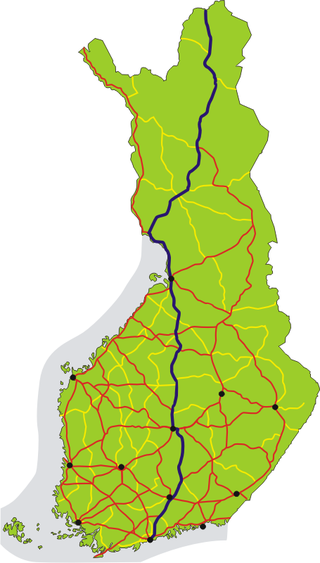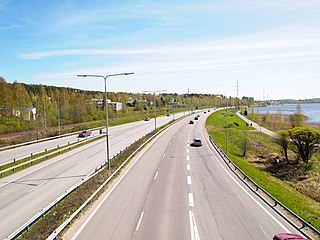
Highways in Finland, or Main roads, comprise the highest categories of roads in Finland:

Highways in Finland, or Main roads, comprise the highest categories of roads in Finland:
Highways numbered from 1 to 7 radiate from the capital Helsinki (Highways 2, 5 and 6 diverge from 1, 4 and 7, respectively), while highways 8 to 10 radiate from Turku on the south-western coast of Finland. Highways 11 and 12 originate in Tampere. The rest of the highways start from other major cities.
Sections of highways between major cities have often been upgraded to motorways, for example between Helsinki and Tampere. Since Finland is a large and sparsely populated country, there is no reason to upgrade all highways to motorways.
The motorway network totals 926 kilometres (575 mi). In addition to that, there are 124 kilometres (77 mi) of motortrafficways, which are reserved only for motor traffic. [1]



The former routes of the following highways differ significantly from the current ones, or have been completely abolished.


Finnish Commuter Airlines Oy, trading as Finncomm Airlines, was a regional airline with its head office on the grounds of Seinäjoki Airport in Ilmajoki, Finland, near Seinäjoki. The carrier operated flights to Estonia, Germany, Lithuania, Romania, Sweden and 16 destinations within Finland from its base at Helsinki Airport. The airline was a member of the European Regions Airline Association. Finncomm Airlines was the largest domestic air carrier in Finland in terms of number of flights.
Finland is divided into 69 sub-regional units. The sub-regions are formed by groups of municipalities within the 19 regions of Finland. The sub-regions represent a LAU 1 level of division used in conjunction with the Nomenclature of Territorial Units for Statistics.

Sokos is a chain of department stores in Finland that is part of the S Group, which also operates the hotel chain, Sokos Hotels.
Metropoli is a Finnish free-of-charge magazine aimed for young adults, available in various cities in Finland.

The Catholic Church in Finland is part of the worldwide Catholic Church, under the spiritual leadership of the Pope in Rome.

The Roman Catholic Diocese of Helsinki is a Latin Church diocese of the Catholic Church based in Helsinki, which comprises the whole of Finland. The diocese is divided into eight parishes.

Finnish national road 4 is a highway in Finland. It is the main route from Helsinki to Northern Finland and a major road link in the country. It runs from Erottaja in Helsinki to Sami Bridge in Utsjoki. The road is 1,295 kilometres (805 mi) long, making it Finland's longest highway. The road is also part of the European route E75 and it is a part of TERN; the section between Oulu and Kemi is part of the European route E8.
As of 2009, Finland has used three models for local public transport. The implementation of these models was regulated by national laws of passenger transport, which were abolished after European Union regulations and laws of public transport service (869/2009) came into effect on December 3, 2009. The Finnish government-owned railways are regulated by specific laws. The local railways in Helsinki are regulated by the city's own laws and regulations.
The history of rail transport in Finland began on January 31, 1862, with the opening of the railway line between Helsinki and Hämeenlinna. By 1900 most of the future main lines had been constructed, including the line to St. Petersburg. By the time of the birth of the new Finnish Republic in 1917 lines connected all major cities, major ports, and reached as far as the Swedish border, and inner Finland as far north as Kontiomäki in Paltamo region, as well as eastwards into Karelia.
Polish Legion in Finland was a military unit made up of ethnic Poles who had been soldiers of the Russian Imperial Army during World War I and stationed in the Grand Duchy of Finland. Created on April 24, 1917, in Viipuri, the unit existed until March 1, 1918. It comprised an infantry battalion in Viipuri, an infantry company in Ino, and a heavy artillery battery in Sveaborg. At its peak, the Legion comprised 37 officers and 1,700 soldiers and was commanded by Captain Stanisław Bogusławski.

OnniBus.com is a Finnish express coach operator. It commenced operating in 2011.

The Finnish national road 9 is a main route. It runs from Turku through Loimaa, Tampere, Jämsä, Jyväskylä, Kuopio, Outokumpu and Joensuu to the Niirala border guard station in Tohmajärvi, right next to the Russian border. The length of the road is 663 kilometres (412 mi).